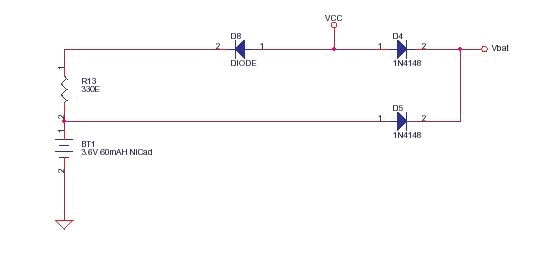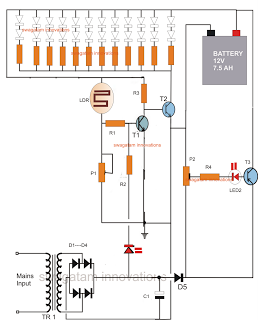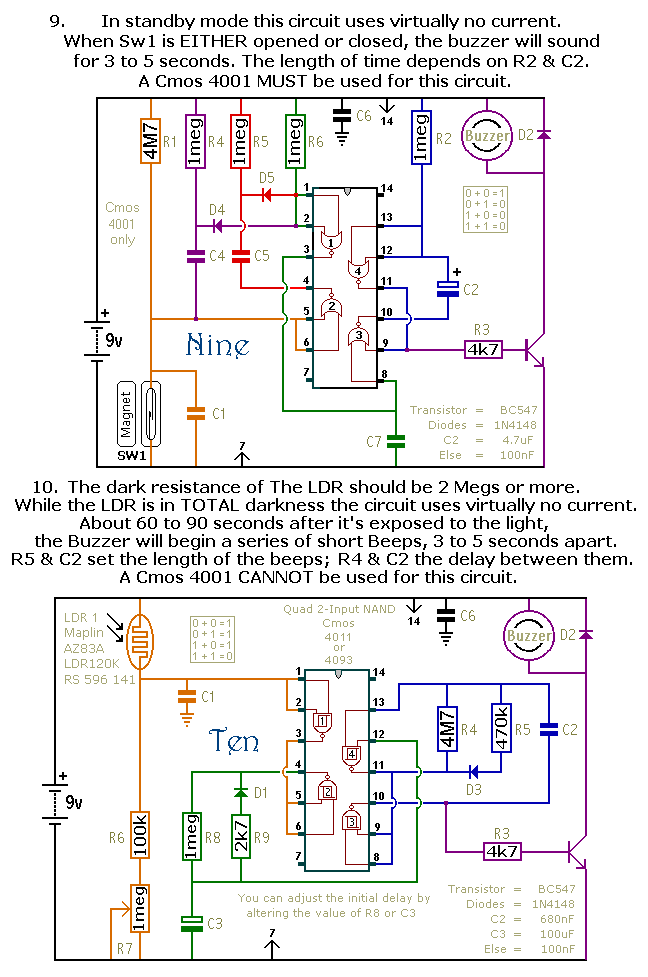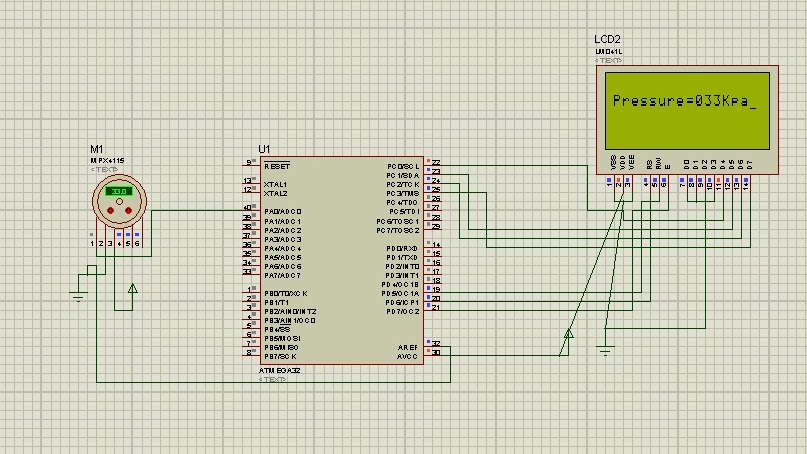
Battery Backup for SRAM or Microcontroller

This circuit functions as a low-cost battery backup solution for SRAM and microcontroller/microprocessor applications. It utilizes 1N4148 diodes to prevent battery discharge back to the power source. Diode D8 provides a one-way path for charging the battery through resistor R13, which limits the current. Diode D4 ensures a unidirectional supply to the chip when power is present, while D5 serves as a backup supply during power failure. A real-time clock, RAM, or processor can be placed in standby or sleep mode during power outages. If the chip is not designed for smart operation, it is essential that all outputs are high impedance or floating during power failure. Avoid using pull-up resistors or voltage divider circuits connected to Vbat, which supplies power to the chip. There should be no leakage paths from Vbat, and the decoupling capacitor for the chip must be of plastic construction. For short-term data retention or when using CMOS logic chips, a 4700µF capacitor can be used in place of a battery, providing several hours of power but requiring a larger PCB footprint. For long-term use, a battery with a higher ampere-hour (AH) capacity is recommended. The circuit operates with a regulated 5V DC supply. Vbat and Vcc can be monitored using a comparator, such as the LM339, which can generate reset or low battery signals. Power-on and power-down resets can corrupt data during brownouts, blackouts, or spikes, necessitating backup data storage on flash memory. SRAM is preferable for rapid read/write operations, while flash memory is better suited for storing values like lookup tables. Power fluctuations may cause the chip to hang, potentially requiring a watchdog timer. Traditionally, CPU activity was monitored through keyboard-display scanning on an I/O port, where the absence of pulses indicated that the CPU needed to be reset.
This circuit design incorporates essential elements for ensuring reliable operation during power interruptions. The use of 1N4148 diodes is critical for maintaining unidirectional current flow, which protects the battery from discharging back into the power source. The inclusion of resistor R13 not only limits the charging current but also enhances the safety of the battery charging process.
The design allows for effective management of power states in the microcontroller or processor. By placing the chip in a low-power mode during outages, unnecessary power consumption is minimized. The requirement for high impedance outputs during power failure is crucial, as it prevents inadvertent current draw that could deplete the backup power source.
For applications requiring short-term data retention, the use of a large capacitance capacitor, such as the 4700µF option, can serve as a temporary power source. However, this solution comes with a trade-off in terms of PCB real estate, as larger capacitors occupy more space. For applications necessitating extended backup times, a battery with a sufficient AH rating is essential to ensure that the system remains operational for the desired duration.
Monitoring Vbat and Vcc levels using a comparator like the LM339 allows for proactive management of the power supply. This feature is vital for generating alerts regarding low battery conditions and ensuring that the system can respond appropriately to voltage drops.
The potential for data corruption during power fluctuations emphasizes the need for robust data management strategies. Utilizing flash memory for data storage provides a reliable method for retaining critical information, while SRAM is better suited for applications with high read/write frequency due to its faster access times.
Incorporating a watchdog timer can enhance system reliability by monitoring CPU activity. This feature ensures that the system can recover from non-responsive states, thereby maintaining overall operational integrity. The traditional method of monitoring CPU activity through I/O port scanning remains a viable strategy for detecting system malfunctions.
Overall, this circuit design addresses various challenges associated with power management in microcontroller and SRAM applications, providing a comprehensive solution for ensuring data integrity and system reliability during power interruptions.This circuit can be used as a low cost SRAM and Microcontroller-Microprocessor Battery Backup. All the diodes are 1N4148, The diodes prevent battery discharge back to power source. D8 gives a one way path to charge Battery thru R13 which limits current. D4 ensures a one way path of supply to chip when power is present. D5 is backup supply on power failure. The chip a real time clock, RAM or Processor can be put to standby or sleep on power failure. If it is not a smart chip then make sure on power failure all outputs of chip are high impedance or floating. do not use any pullups or resistor dividers to Vbat, which is the supply to chip. There should be no leakage path from Vbat, decoupling cap of chip must be plastic. If you want to use this circuit for short term retention or for CMOS logic chips then you can use a 4700uF Cap in place of battery.
This works for many hours but the cap has big footprint on PCB. For long duration use more battery AH Ampere-Hour. Vcc is 5V DC regulated. The Vbat and Vcc can be monitored with comparator like LM339, this circuit can generate the reset or low battery signals. The power on reset and power down reset can corrupt data on brown outs or black outs or even spikes and EMI.
So back up data on flash. For Rapid writing and reading SRAM is better and if write-read cycles are high SRAM is best. But if you need to store values and refer to them like a look-up table flash is better. The power fluctuations can hang the chip, so a watchdog chip may be required. The conventional way was the to monitor the keyboard-display scan on a i/o port. If the pulses are coming at the rate you programmed the cpu is alive and kicking and doing its job. If the CPU is Playing Hookey, then the pulses stop coming and it has to be reset. We aim to transmit more information by carrying articles. Please send us an E-mail to wanghuali@hqew. net within 15 days if we are involved in the problems of article content, copyright or other problems. We will delete it soon. 🔗 External reference
This circuit design incorporates essential elements for ensuring reliable operation during power interruptions. The use of 1N4148 diodes is critical for maintaining unidirectional current flow, which protects the battery from discharging back into the power source. The inclusion of resistor R13 not only limits the charging current but also enhances the safety of the battery charging process.
The design allows for effective management of power states in the microcontroller or processor. By placing the chip in a low-power mode during outages, unnecessary power consumption is minimized. The requirement for high impedance outputs during power failure is crucial, as it prevents inadvertent current draw that could deplete the backup power source.
For applications requiring short-term data retention, the use of a large capacitance capacitor, such as the 4700µF option, can serve as a temporary power source. However, this solution comes with a trade-off in terms of PCB real estate, as larger capacitors occupy more space. For applications necessitating extended backup times, a battery with a sufficient AH rating is essential to ensure that the system remains operational for the desired duration.
Monitoring Vbat and Vcc levels using a comparator like the LM339 allows for proactive management of the power supply. This feature is vital for generating alerts regarding low battery conditions and ensuring that the system can respond appropriately to voltage drops.
The potential for data corruption during power fluctuations emphasizes the need for robust data management strategies. Utilizing flash memory for data storage provides a reliable method for retaining critical information, while SRAM is better suited for applications with high read/write frequency due to its faster access times.
Incorporating a watchdog timer can enhance system reliability by monitoring CPU activity. This feature ensures that the system can recover from non-responsive states, thereby maintaining overall operational integrity. The traditional method of monitoring CPU activity through I/O port scanning remains a viable strategy for detecting system malfunctions.
Overall, this circuit design addresses various challenges associated with power management in microcontroller and SRAM applications, providing a comprehensive solution for ensuring data integrity and system reliability during power interruptions.This circuit can be used as a low cost SRAM and Microcontroller-Microprocessor Battery Backup. All the diodes are 1N4148, The diodes prevent battery discharge back to power source. D8 gives a one way path to charge Battery thru R13 which limits current. D4 ensures a one way path of supply to chip when power is present. D5 is backup supply on power failure. The chip a real time clock, RAM or Processor can be put to standby or sleep on power failure. If it is not a smart chip then make sure on power failure all outputs of chip are high impedance or floating. do not use any pullups or resistor dividers to Vbat, which is the supply to chip. There should be no leakage path from Vbat, decoupling cap of chip must be plastic. If you want to use this circuit for short term retention or for CMOS logic chips then you can use a 4700uF Cap in place of battery.
This works for many hours but the cap has big footprint on PCB. For long duration use more battery AH Ampere-Hour. Vcc is 5V DC regulated. The Vbat and Vcc can be monitored with comparator like LM339, this circuit can generate the reset or low battery signals. The power on reset and power down reset can corrupt data on brown outs or black outs or even spikes and EMI.
So back up data on flash. For Rapid writing and reading SRAM is better and if write-read cycles are high SRAM is best. But if you need to store values and refer to them like a look-up table flash is better. The power fluctuations can hang the chip, so a watchdog chip may be required. The conventional way was the to monitor the keyboard-display scan on a i/o port. If the pulses are coming at the rate you programmed the cpu is alive and kicking and doing its job. If the CPU is Playing Hookey, then the pulses stop coming and it has to be reset. We aim to transmit more information by carrying articles. Please send us an E-mail to wanghuali@hqew. net within 15 days if we are involved in the problems of article content, copyright or other problems. We will delete it soon. 🔗 External reference





